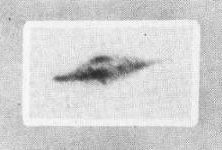Article/Document:
Trindade Island
Loy Lawhon, About.com
original source | fair use notice
Summary: Brief overview and summary of the Trinidade Island Case
It is the image of the ungraspable phantom of life;
and this is the key to it all.
(Moby Dick, or The White Whale by Herman Melville)
16 January 1958
South Atlantic Ocean
Trindade Island
600 miles off Bahia, Brazil
As its contribution to the International Geophysical Year, the Brazilian Navy set up a scientific research installation on the small, rocky island of Trindade to conduct atmospheric and oceanographic experiments. soon after arriving at the island, the researchers began seeing UFOs.
The climax of the sightings came on 16 January 1958. The Almirante Saldanha, which had been fitted up as a hydrographic research vessel, was anchored off the south coast of the island. The deck was full of officers and crewmen preparing for a voyage back to Rio de Janeiro.
One of the crew spotted an aerial object approaching the island, and in all it was seen by 48 crew members and passengers. A civilian photographer Alimo Barauna, who was underwater photographer for the team, was on deck. He later said:
...Suddenly Mr. Amilar Viera and Captain Viegas called to me, pointing to a certain spot in the sky and yelling about a bright object which was approaching the island.
It glittered at certain moments, perhaps reflecting the sunlight, perhaps changing its own light - I don't know. It was coming over the sea, moving toward the point called the Galo Crest. I had lost 30 seconds looking for the object, but the camera was already in my hands, ready, when I sighted it clearly sihouetted against the clouds. I shot two photos before it disappeared nehind Desajado Peak. My camera was set at speed 125, with the aperture at f/8, and this was the cause of an overexposure error, as I discovered later.
The object remained out of sight for a few seconds - behind the peak - reappearing bigger in size and flying in the opposite direction, but lower and closer than before, and moving at higher speed. I shot the third photo. The fourth and fifth ones were lost, not only because of the speed the saucer was moving, but also for another reason: in the confusion produced as a result of the sighting, I was being pulled and pushed by other persons also trying to spot the object...
It was moving again toward the sea, in the direction from which it had come, and it appeared to stop in mid-air for a brief time. At that moment I shot my last photo. After about 10 seconds, the object continued to increase its distance from the ship, gradually diminishing in size and finally disappearing into the horizon.
The object was described as being gray, metallic, and surrounded by a greenish haze or mist. This may account for its odd appearance. The photos can be viewed at MUFOR.
Barauna removed the film from the camera, and an hour later, he and Captain Viegas went into the darkroom and processed the film, while Cmdr. Bacellar waited outside the door. Bacellar examined the negatives and then showed them to other witnesses who verified that the object in the pictures was the same object they had seen.
When they reached Rio, Barauna made prints from the negatives and Bacellar took them to the Navy Ministry. Barauna was called in to naval headquarters for questioning two days later, and his negatives were sent to the Cruzerio do Sul Aerophotogrammetric Service for analysis. The photos were declared genuine and were released to the press. The press interviewed passengers and crewmembers from the Almirante Saldanha and printed their versions of the sighting.
Brazil's House of Representatives requested further information from the navy, and they were given a secret report prepared by a Captain Brandao, who concluded that:
The existence of personal reports and of photographic evidence, of certain value considering the circumstance involved, permits the admission that there are indications of the existence of unidentified aerial objects.
Debunking astronomer Donald Menzel tried to make a case for Barauna faking the photos, but failed to prove his case.
In 1978, Ground Saucer Watch's photographic experts subjected good-quality prints of the photos to computerized image analysis, and the found:
The UFO image is over 50 feet in diameter. The UFO image in each case reveals a vast distance from the photographer/camera. The photographs show no signs of hoax(i.e., a hand-thrown or suspended model). The UFO image is reflecting light and passed all computer tests for an image with substance. The image represents no known aircraft or experimental balloon. Digital densitometry reveals a metallic reflection.
We are of the unanimous opinion that the Brazilian photos are authentic and represent an extraordinary flying object of unknown origin.
Read more articles on this topic:






